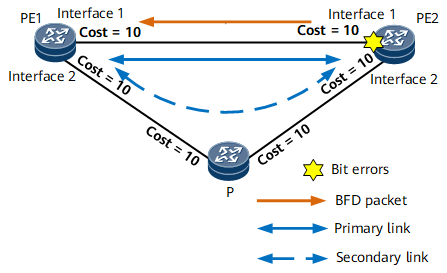Bit-Error-Triggered IGP Route Switching
Background
Bit-error-triggered section switching can cope with link bit errors. If bit errors occur on both the primary and secondary links, bit-error-triggered section switching changes the interface status on both the primary and secondary links to bit-error-detection Down. As a result, services are interrupted because no link is available. To resolve the preceding issue, deploy bit-error-triggered IGP route switching. After the deployment is complete, link bit errors trigger IGP route costs to be adjusted, preventing upper-layer applications from transmitting service traffic to links with bit errors. Bit-error-triggered IGP route switching ensures normal running of upper-layer applications and minimizes the impact of bit errors on services.
Implementation Principles
Link-quality bit error detection must be enabled on an interface. After detecting bit errors on an inbound interface, a device notifies the interface management module of the bit errors. The link quality level of the interface then changes to Low, triggering an IGP (OSPF or IS-IS) to increase the cost of the interface's link. In this case, IGP routes do not preferentially select the link with bit errors. After the bit errors are cleared, the link quality level of the interface changes to Good, triggering the IGP to restore the original cost for the interface's link. In this case, IGP routes preferentially select the link again. The device also notifies the BFD module of the bit error status, and then uses BFD packets to advertise the bit error status to the peer device.
If bit-error-triggered IGP route switching also has been deployed on the peer device, the bit error status is advertised to the interface management module of the peer device. The link quality level of the interface then changes to Low or Good, triggering the IGP to increase the cost of the interface's link or restore the original cost for the link. IGP routes on the peer device then do not preferentially select the link with bit errors or preferentially select the link again.
If bit-error-triggered IGP route switching is not deployed on the peer device, the peer device cannot detect the bit error status of the interface's link. Therefore, the IGP does not adjust the cost of the link. Traffic from the peer device may still pass through the link with bit errors. As a result, bidirectional IGP routes pass through different links. The local device can receive traffic properly, and services are not interrupted. However, the impact of bit errors on services cannot be eliminated.
For example, on the network shown in Figure 1, link-quality bit error detection is enabled on each interface, and nodes communicate through IS-IS routes. In normal cases, IS-IS routes on PE1 and PE2 are preferentially transmitted over the primary link. Therefore, traffic in both directions is forwarded over the primary link. If PE2 detects bit errors on interface 1:
PE2 adjusts the link quality level of interface 1 to Low, triggering IS-IS to increase the cost of the interface's link to a value (for example, 40). PE2 uses a BFD packet to advertise the bit errors to PE1.
After receiving the BFD packet, PE1 also adjusts the link quality level of interface 1 to Low, triggering IS-IS to increase the cost of the interface's link to a value (for example, 40).
IS-IS routes on both PE1 and PE2 preferentially select the secondary link, because the cost (20) of the secondary link is less than the cost (40) of the primary link. Traffic in both directions is then switched to the secondary link.
If bit-error-triggered IGP route switching is not supported or enabled on PE1, PE1 cannot detect the bit errors. In this case, PE1 still sends traffic to PE2 through the primary link. PE2 can receive traffic properly, but services are affected by the bit errors.
If PE2 detects bit errors on both interface 1 and interface 2, PE2 adjusts the link quality levels of the interfaces to Low, triggering the costs of the interfaces' links to be increased to 40. IS-IS routes on PE2 still preferentially select the primary link to ensure service continuity, because the cost (40) of the primary link is less than the cost (50) of the secondary link. To eliminate the impact of bit errors on services, you must manually restore the link quality.

Bit-error-triggered section switching and bit-error-triggered IGP route switching are mutually exclusive.
Usage Scenario
If LDP LSPs are used, deploy bit-error-triggered IGP route switching to cope with link bit errors on the LDP LSPs. Bit-error-triggered IGP route switching ensures service continuity even if bit errors occur on both the primary and secondary links on an LDP LSP. Therefore, it is recommended that you deploy bit-error-triggered IGP route switching.
